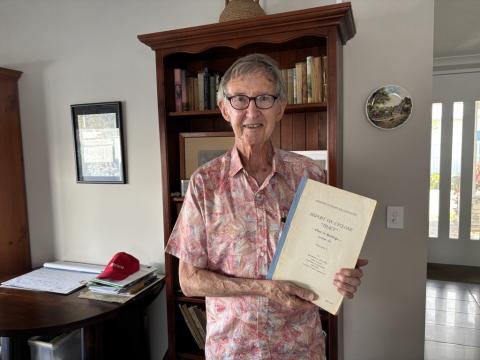


Lessons learned post-disaster including changes to Australian building codes and tsunami warnings were highlighted in a special December Hazardous Webinar.
Held on 12 December 2024, Natural Hazards Research Australia (the Centre) commemorated the 50-year anniversary of Cyclone Tracy and 20-year anniversary of the 2004 Indian Ocean Tsunami with an expert panel sharing their lived experiences and lessons learned from the tragic disasters.
Centre Board member Doug Smith reflected on his experience as a member of Victoria Police when he was posted to Darwin to aid the recovery efforts immediately following Cyclone Tracy in December 1974.
Doug shared photos and stories from his time in Darwin, emphasising the ongoing lack of communication significantly disrupted evacuation and response efforts following the cyclone.
Doug recalled that he and his colleagues used paper and pen to note evacuation, injured and deceased information to communicate with the residents and survivors they encountered.
“It was really important to get information out to people because no one really knew what was occurring,” Doug said.
Doug and his colleagues went house-to-house to make sure everyone was accounted for to help with the evacuation. Approximately 35,000 people in Darwin were evacuated as quickly as possible, an enormous challenge due to the lack of mass communication technology.
Adj Prof George Walker led the redefinition of building standards in the aftermath of Cyclone Tracy, catalysing building code changes that continue to improve infrastructure resilience to catastrophic disasters today. George shared the engineering impacts and building code changes brought about by the devastation wrought on 24 December 1974, how the disaster and recovery shifted how disaster research is carried out in Australia and Cyclone Tracy's ongoing global impact on reinsurance.
“The magnitude of Cyclone Tracy was due to the impact on people, the loss of community functionality and the time and cost of the recovery, not the number of deaths and injuries,” George said. “Today, this is known as community disaster resilience.”
George stressed the need for clearly defined key parameters when planning community disaster resilience, including the magnitude and type of the disaster.
“It's crucial to measure the impact on both individuals and overall community disaster resilience,” George said.
“Once we have defined these parameters, we must establish acceptable minimum levels of community impact and resilience for different magnitudes of events.”
George believes that Geographic Information Systems (GIS) modelling of community disaster resilience, based on the type and magnitude of a disaster, can be helpful in this process which poses a significant challenge for current and future disaster risk reduction researchers.

Image: Adj Prof George Walker holding the Report on Cyclone Tracy - Effect on Buildings, 1975
Dr Jane Sexton, Executive Manager of Hazard and Risk at Queensland Fire Department, leads a tsunami risk modelling project in Queensland through the Coastal and Estuarine Mitigation Program and has been a member of the Australian Tsunami Advisory Group and its predecessors since 2005.
Jane reflected on the tsunamis that have affected Australia and Australians over the last two decades, highlighting that the country is not immune to tsunamis caused by nearby earthquakes. Since 2004, significant resources have been channelled into Australian tsunami warning systems and modelling.
Jane emphasised the importance of understanding risks to manage them effectively.
“This includes incorporating First Nations knowledge and considering other potential sources of tsunamis, such as volcanic activity and submarine landslides,” said Jane.
Managing tsunami risk requires community awareness, evacuation maps and strategic land-use planning. Jane also highlighted opportunities to integrate tsunami hazards into coastal adaptation planning and implementation, as well as activities and drills on and around World Tsunami Awareness Day.
The webinar underscored the importance of reflection and learning post-disaster to improve preparedness, response and recovery in the future. The panel demonstrated the way key lessons are actively put into action to improve the safety, resilience and sustainability of Australian communities.
Watch the recording below: